In Russia, drilling activity was on the rise in 2007 and 2008 while production fell; Kazakhstan saw increases in both drilling and production for 2007 and 2008.
Maxim Matuk and Yury Krasheninnikov, RPI, Moscow, Russia
The key developments in the Russian oil industry in 2007 and 2008 were falling oil production levels demonstrated by the majority of the Russian oil majors, a surge in production and exploration drilling and a continuing decline in the efficiency of production stimulation. The fundamental factors that shaped this decline were the aging upstream asset base of the Russian oil companies and their underinvestment in old and new field development in the previous years. Overall, the Russian oil industry faces a formidable internal challenge, which-along with the steep fall in oil prices in 2008-will test the companies in the management of operations, technology and human resources. In this article, energy research and consulting firm RPI gives an overview of the performance of the Russian oil industry in 2007 and a brief outlook for 2008.
2007 RUSSIAN PRODUCTION
In 2007, Russian upstream activity developed in line with the prevailing trends of recent years. Total oil and gas condensate production by all petroleum companies, both major and small, amounted to 491.3 million tons (MMt), or 9.79 million boepd, which represented a 2.2%, or 10.8 MMt, increase on 2006. This growth rate is comparable to those of the previous two years, which did not exceed 2.5% per year, Fig. 1.
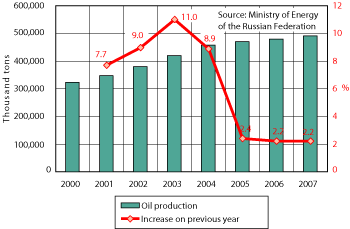 |
|
Fig. 1. Russian oil production and year-on-year production growth, 2000-2007.
|
|
Total 2007 production of the large, vertically integrated petroleum companies was 440.7 MMt, 89.9% of total production, while independent oil producers accounted for 50.6 MMt (10.1%); production by independent companies includes production by Gazprom, Novatek, Yukos and operators of production sharing agreements, e.g., Sakhalin-1.
As in 2006, the largest production volumes in 2007 came from Lukoil and Rosneft, Fig. 2. However, in 2007 Rosneft increased its oil production level by 35.9% to 110.4 MMt (2.2 million bopd) and became the leading oil producer in Russia. Rosneft managed to achieve such an impressive result largely due to production growth at Priobskoye Field, operated by its West Siberian subsidiary Yuganskneftegas-formerly the core production asset of Yukos. Other important contributors to Rosneft’s production boost were two more former Yukos assets-Tomskneft and Samaraneftegas-the acquisition of which was completed in 2007.
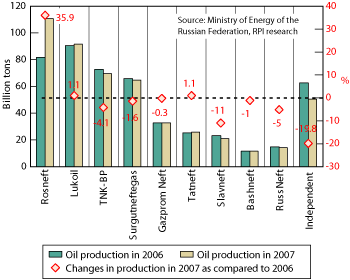 |
|
Fig. 2. Russian oil production and year-on-year production growth, 2006-2007.
|
|
Lukoil, the production leader in 2006, increased oil and gas condensate production in 2007 by only 1.1%, to the level of 91.4 MMt (1.82 million bopd). The company has been showing similar production growth rates over the last several years.
Besides Lukoil and Rosneft, production growth was demonstrated by Tatneft, which produced 25.7 MMt, a 1.1% increase on 2006. The rest of the vertically integrated companies showed production decline in 2007.
The most significant year-to-year drop in production was demonstrated by the independent companies, 19.8%, down to the level of 50.6 MMt. However, excluding Yukos from the group, the independents showed production growth of 15.5%.
Both short- and long-term reasons caused the production dynamics seen in 2007.
Short-term reasons. Taxation is placed in the short-term category, since it is currently undergoing significant changes in response to the changing industry and market conditions. In 2007 the total amount of taxes and duties payable by petroleum companies could reach 96 cents for a dollar of profit, thus leaving the petroleum companies incapable of investing in their own development.
A sharp increase in drilling costs is also a factor. The first half of 2007 saw a jump in prices of materials used by oilfield service companies for drilling. The growth in prices of some materials (such as rolled metal, tubing, cement, electric cables) was as high as 80%, resulting in a quick appreciation of drilling services.
Another short-term factor was the deficit of drilling capacity in the market. The surge in the demand for production and exploration drilling that occurred in late 2006 to early 2007 caught the independent oilfield service companies and the drilling divisions of oil and gas companies unprepared. As a result, they were unable to quickly scale up their drilling capacities to meet the increased market demand.
Long-term reasons. The fall of production growth across the Russian oil industry in 2007 was largely due to reserves depletion in most fields under development. Most oil fields being developed in Russia are mature fields, some of which began development during the time of the USSR. Oil flowrates in these fields have been declining.
Decreased production from stimulation in existing wells is another long-term reason. From 2003 to 2006, petroleum companies extensively used various production intensification methods on operating wells. As a result, in 2007 the possibilities for production stimulation on existing wells began to decrease significantly.
PRODUCTION DRILLING
The drop of base production levels in the major fields, which greatly affected nearly all petroleum companies, was a major incentive for boosting production drilling volumes in 2007, Fig. 3. Another factor that contributed to the increase in production drilling was the post-Yukos stabilization, when the oil companies that had earlier favored production intensification methods over large-scale investment in production, started building up production drilling until it reached a record 13.76 million m (45 million ft). Growth in production drilling footage in 2007 was demonstrated by all the Russian oil and gas majors, with Rosneft leading the group with an impressive 79.8% growth to 2.5 million m drilled. Such a high increase in the company’s production drilling was mainly due to buildup of production at Priobskoye Field, which is both the largest and youngest of the fields developed by Rosneft. Also, about a third of Rosneft’s drilling growth could be attributed to the acquisition of Tomskneft and Samaraneftegas.
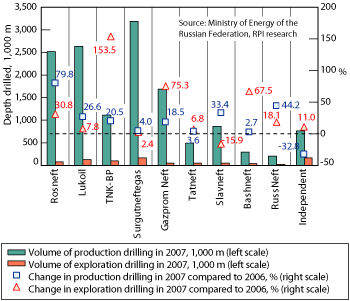 |
|
Fig. 3. Production and exploration drilling in Russia in 2007 and increase on 2006.
|
|
The production drilling footage of Lukoil, the second-largest producer in Russia, equaled 26.4 million m, a 26.6% increase compared to 2006. Surgutneftegas showed a modest 4% growth over 2006, yet its absolute result-3.19 million m-was the best of all the Russian oil companies. Most of the company’s fields are mature; thus large-scale production drilling is essential to maintain production rates. Besides, the development by Surgutneftegas of the “new” Talakanskoye Field in Eastern Siberia requires large volumes of production drilling.
Total production drilling footage by independent companies amounted to 762,000 m, a 32.8% decrease compared to 2006 when accounting for Yukos-whose production drilling was phased out in 2007-and to an increase of 14.3% when excluding Yukos.
In exploration drilling the Russian oil majors demonstrated very different dynamics, Fig. 3. The highest year-on-year increase, of 153.5%, was demonstrated by TNK-BP, with 102,000 m, to which development of Verkhnechonskoye Field in Eastern Siberia contributed heavily.
Gazprom Neft grew exploration drilling volume by 75.3% to 53,400 m, almost entirely on account of exploration in the Yamal-Nenets Autonomous District. The independents, not accounting for Yukos, have grown exploration drilling by an impressive 82.4%.
Following a number of years of declining exploration drilling volumes, Lukoil demonstrated a 7.8% increase to 125,000 m. Surgutneftegas overturned its decrease in exploration drilling of the mid-2000s by showing 2.4% growth in 2007, while maintaining its leader position in exploration drilling volume with 168,000 m. Most of the company’s exploration drilling took place in Talakanskoye and neighboring fields, as well as in Timan-Pechora.
As growing production drilling led to an increasing number of wells brought on stream, the highest results were demonstrated by Rosneft, Lukoil and Slavneft, Table 1. By increasing the number of production wells, Slavneft tries to compensate for the decrease in production. Significant growth in the number of new wells brought on stream also came from Gazprom Neft, TNK-BP and RussNeft.
| TABLE 1. New wells brought onstream and production effect from new wells |
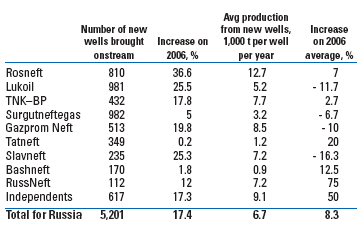 |
|
As Table 1 shows, the production gains effect from the wells brought onstream varies significantly. The greatest effect was achieved by Rosneft-12,700 t per well, with an increase of this parameter compared to 2006 of only 7%. At the heart of this performance lies the relatively young fields of Yuganskneftegas.
Lukoil’s production per new well amounted to 5,200 t. This came as a drop of 11.7% on 2006, with the main causes being the company’s production asset portfolio of aging fields, as well as constrained production from new wells in Timan-Pechora due to delays in commissioning of oil transportation infrastructure.
Gazprom Neft, Slavneft, RussNeft and TNK-BP demonstrated comparable levels of production gains from new wells, but their year-on-year dynamics were very different: a striking 75% boost by Russneft and modest growth of 2.7% by TNK-BP on one side, and decreases shown by Slavneft (16.3%) and Gazprom Neft (10%) on the other. The independent oil companies grew their averages by 50% to 9,100.
In order to maintain production levels during the last 2-3 years, oil companies actively used various intensification methods, of which fracturing was particularly popular. TNK-BP was the leader in the number of fracturing operations performed in 2007 with 1,450 jobs (9.7% growth on 2006) performed, most of them in Samotlor Field. Rosneft and Lukoil showed comparable levels-735 and 762 jobs, respectively. The dynamics of the latter two companies were quite different: Rosneft showed an increase on 2006 in the number of fracturing jobs by 17.4%, while Lukoil reduced its numbert by 24%. The highest percentage growth in jobs was demonstrated by Tatneft (31%), though from a relatively low base.
Of all oil companies, average production gains from fracturing grew year-on-year in 2007 only in the cases of Bashneft (11.1%), RussNeft (5%) and the independents (5%), Table 2. The rest of the companies either maintained their 2006 levels or saw efficiency decline. Tatneft demonstrated the highest average effect, 3,900 t, while Gazprom Neft had the steepest drop in efficiency compared to 2006 (32.4%).
| TABLE 2. Number of and production gains of fracturing jobs, 2006-2007 |
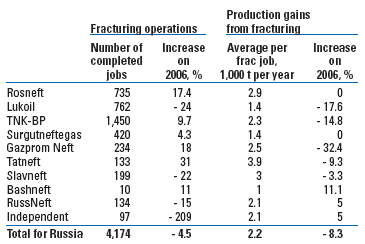 |
|
DEVELOPMENTS AND TRENDS IN 2008 RUSSIAN UPSTREAM
Russia’s oil production volumes will most likely show a small decline in 2008 compared to 2007. Under the current circumstances, the Russian oil-producing companies have largely exhausted the potential for organic production growth from the existing asset base. Russia does have considerable discovered yet largely untapped reserves in the frontier onshore regions of Timan Pechora and Eastern Siberia, as well as in its several offshore basins. However, the oil companies are increasingly experiencing a deficit of investment resources for development of new projects, which seriously hampers production growth. The reduction of the tax burden on oil companies that is being gradually introduced by the Russian government and parliament (tax breaks for selected onshore and offshore regions already have been passed), will give some impulse to Russia’s upstream, yet it will have to be seen whether it is enough to boost oil production.
Drilling volumes in 2008 are expected to grow compared to 2007 (for production drilling, the first-half results for 2008 were up 8% compared to the same period in 2007), because boosting production and exploration drilling is critical for maintaining production levels.
Application of fracturing is expected to decrease, following active use of this and other production intensification methods during the last several years. The number of good candidates for fracturing among the operating wells has decreased significantly, while repeat fracturing has not been bringing adequate oil production gains.
In view of the upcoming oil production decrease, increased attention is expected on the part of the oil companies to high-tech, efficiency-driven methods of production intensification, enhanced oil recovery and formation evaluation.
KAZAKHSTAN
With 39.8 billion bbl of proved oil reserves, Kazakhstan ranked ninth in the world and second in the FSU after Russia as of the end of 2007, according to the BP Statistical Review of World Energy 2008. Kazakhstan’s oil production in 2007 amounted to 67.2 MMt (1.4 million bopd), which puts it in 19th place, following the UK. At current production levels, Kazakhstan has a reserves-to-production ratio of 78.9 yr, which is significantly higher than the world average of 41.6 yr.
Kazakhstan also possesses considerable gas potential with proved reserves of 1.9 trillion cubic meters (67.2 Tcf), according to the BP Statistical Review of World Energy 2008. At the 2007 gas production level of 29.6 billion cubic meters (1,057 Bcf), the reserves-to-production ratio is 64 yr.
From 2000 to 2007, annual oil production in Kazakhstan has grown almost two-fold, or on average by nearly 10% per year, Fig. 4.
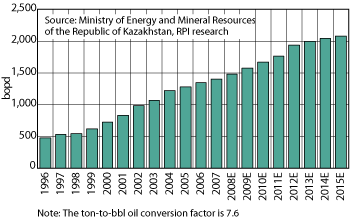 |
|
Fig. 4. Kazakhstan’s oil production in 1996-2015.
|
|
INDUSTRY STRUCTURE: CHANGING BALANCE OF POWER
Sixty four companies are engaged in oil production in Kazakhstan. However, the bulk of oil production comes from 11 operators that produce over 1 MMt per year (about 21,000 bopd) of crude each; they account for 90% of total oil production in the country, Fig. 5. In this category a group of leaders, which are far ahead of other market players, can be distinguished: TengizChevroil (TCO) with about 14 MMt (300,000 bpd) in 2007, 21% of the country’s total output; Karachaganak Petroleum Operating (KPO) with 11.6 MMt (250,000 bopd), over 17%; and national company KazMunaiGas (KMG) with 9.5 MMt (205,000 bopd), 14%.
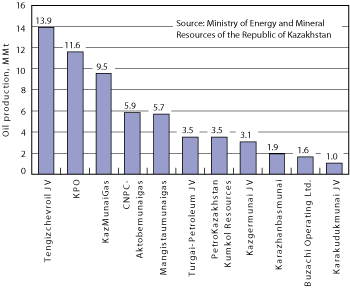 |
|
Fig. 5. Kazakhstan’s major oil producers in 2007.
|
|
The ranking changes significantly if key players’ shares in various companies and projects are taken into consideration. In this ranking system, KMG is the indisputable leader in oil production of the country, Fig. 6.
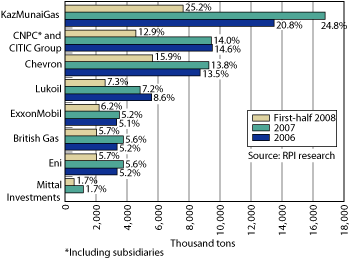 |
|
Fig. 6. Cumulative oil production by key players as share of total country production.
|
|
Since 2006, the national company has been pursuing an aggressive market expansion, re-establishing control over upstream (Fig. 7) and downstream assets that had been previously sold by the government. Amendments to the Subsoil Law introduced in 2005 gave KMG the priority right to acquire the to-be-divested shares in the joint ventures and consortiums in which government companies have an equity stake. Besides, the amendments reserve for KMG a mandatory equity stake of not less than 50% in all new offshore projects.
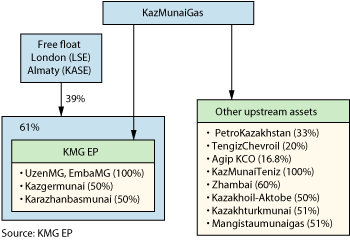 |
|
Fig. 7. National company KMG’s upstream assets.
|
|
During 2006 and 2007, KMG acquired stakes-ranging from 33% to 50%-in three large producers: PetroKazakhstan Inc., Kazgermunai and Karazanbasmunai. In January 2008 following these acquisitions, KMG’s share in Kashagan-the largest offshore field development project-doubled to 16.81% from 8.33%. In July 2008, KMG announced acquisition of 51% interest in Mangistaumunaigas, Kazakhstan’s fifth-largest oil producer. The transaction is expected to be completed by the end of 2008.
The consolidation of assets within the national oil company is one of the measures by which the Kazakhstan government is aiming to increase control over the redistribution of energy resources and over the current oil and gas projects. Another goal is to limit expansion of foreign oil companies, first of all Chinese ones, the acquisition activity of which in the recent years has become of increasing concern to the Kazakhstan authorities.
As Fig. 6 shows, CNPC and other Chinese companies, according to 2007 results, are the second-most important collective player in the country’s oil industry. Their assets already account for 14% of total oil production, and the appetites of the Chinese companies are obviously not limited to that.
A 2007 amendment to the Subsoil Law imposes a moratorium on the resale of newly acquired assets during two years following the date of acquisition, which is meant to serve as an additional barrier for the expansion of foreign companies.
Increased state control over the oil and gas complex is supplemented with an increased tax burden on the industry. Effective May 17, 2008, the export duty for crude oil was set at an initial rate of $15 per bbl; for the time being, projects operating under PSA terms are exempt from this duty. The adoption of a new tax code is expected before the end of this year, which in all likelihood will contain higher tax rates for the oil and gas sector.
OIL BOOM POSTPONED
In the medium term, the Kazakhstan government sets an ambitious task, to rank among the top 10 of the world’s hydrocarbon producers.
According to the latest official forecasts made public in September 2008, oil production in the country is to increase to 80 MMt (about 1,700 bopd) in 2010 and up to 100 MMt (about 2,100 bopd) in 2015. Comparison of these figures with the previous official forecast, 100 MMt in 2010 and 130 MMt in 2015, shows significant downward correction of oil production plans. The decline in oil production forecasts reflects the current industry slowdown in oil production growth, as well as the challenges faced by offshore field development projects.
From 2000 through 2004, oil production annual growth rates were at 12-13%. However, beginning in 2005, production growth slipped to 4-5% in spite of growth in both production and exploration drilling, Fig. 8. In 2008, oil production is expected to reach 70 MMt-4% growth on 2007.
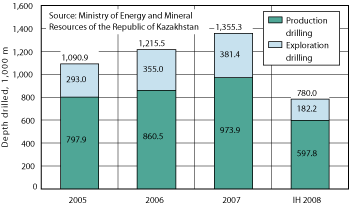 |
|
Fig. 8. Exploration and production drilling in Kazakhstan.
|
|
The main reason for the slowdown of oil production growth is the progressing depletion of the reserve base. Most of the onshore fields have passed production peaks or are approaching them; one of the few exclusions is the Kumkol group of fields that came onstream about a decade ago. Meanwhile, onshore geological exploration in Kazakhstan during the last 15 years has not produced any significant discoveries.
Among the onshore fields, the producing giants Tengiz and Karachaganak have the greatest growth potential. In 2007 they accounted for 77% of oil production growth. Recent commissioning of new field infrastructure at Tengiz is expected to increase oil production to 540,000 bopd from 300,000 bopd. With Phase III development of Karachaganak Field, planned for 2012, production of liquids is expected to grow to 360,000 bopd, or by 42% compared to the 2007 level.
However, most of the increase in Kazakhstan’s discovered reserves and production is due to come from the continental shelf, where some large oil and gas fields were found in the late 1990s and early 2000s. Peak production of the Kashagan project alone is expected to reach 70 MMt per year (1.46 million bopd).
Meanwhile, ambitious plans for intensive development of Caspian Sea resources are far behind schedule. The start of commercial production at Kashagan Field has been repeatedly postponed, and the most recent date announced by the consortium for start of production at Kashagan, October 2013, is likely to be shifted again to a later date. The feasibility of this date has already been questioned by industry experts, who point to the impossibility of starting production in winter.
So far, other offshore projects have not shown encouraging results. Drilling of the first exploration wells at the Kurmangazy, Tyub-Karagan and Atash blocks has not confirmed reserves. The drilling of the second well at Kurmangazy, previously planned for 2008, is most likely to be postponed indefinitely, while the outlook for the Atash and Tyub-Karagan projects remains unclear. 
This article is based on the studies “Russian Oilfield Services Market 2008: Analysis and Outlook” and “Kazakhstan’s Oil and Gas Upstream” released by RPI in November/December 2008.
|
THE AUTHORS
|
| |
Maxim Matuk is research manager at RPI’s oil industry research group, based in Moscow. Maxim’s experience includes market research and strategy consulting projects for oil upstream and downstream clients. He is also one of the principal authors of the Russian Oilfield Service Market study released in December 2008. Prior to joining RPI, Maxim worked as analyst for several market research firms in Russia. He holds a degree in Strategic Management and Marketing from the Moscow State University.
|
|
| |
Yuri Krasheninnikov is senior analyst and project manager at RPI, based at the company’s Moscow office. Yuri has 10 years of experience in research and consulting on the oil and gas industries of Russia and the former Soviet Union. Yuri is the lead author of the Kazakhstan’s Oil and Gas Upstream report released in November 2008; he has also been the lead or contributing author of a number of research studies on the Russian/FSU energy industry. Prior to joining RPI, Yuri worked as analyst and consultant for the Center for Political Technologies, Deloitte & Touche and the Institute for World Economy and International relations. He holds a Masters degree in International Relations from the Moscow State Institute of International Relations.
|
|
|












